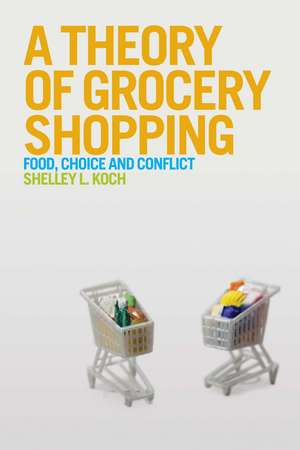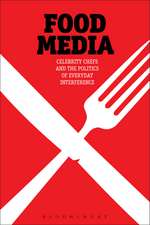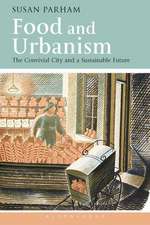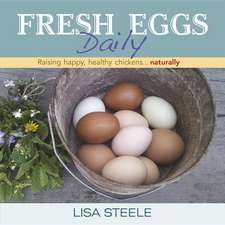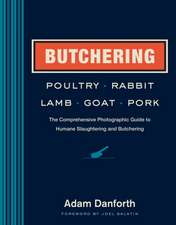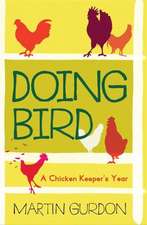A Theory of Grocery Shopping: Food, Choice and Conflict
Autor Dr. Shelley Kochen Limba Engleză Hardback – 30 sep 2012
| Toate formatele și edițiile | Preț | Express |
|---|---|---|
| Paperback (1) | 235.00 lei 3-5 săpt. | |
| Bloomsbury Publishing – 30 sep 2012 | 235.00 lei 3-5 săpt. | |
| Hardback (1) | 654.03 lei 6-8 săpt. | |
| Bloomsbury Publishing – 30 sep 2012 | 654.03 lei 6-8 săpt. |
Preț: 654.03 lei
Preț vechi: 838.06 lei
-22% Nou
Puncte Express: 981
Preț estimativ în valută:
125.15€ • 131.27$ • 104.18£
125.15€ • 131.27$ • 104.18£
Carte tipărită la comandă
Livrare economică 01-15 aprilie
Preluare comenzi: 021 569.72.76
Specificații
ISBN-13: 9780857851505
ISBN-10: 0857851500
Pagini: 144
Ilustrații: 5 bw illus
Dimensiuni: 156 x 234 x 18 mm
Greutate: 0.36 kg
Ediția:New.
Editura: Bloomsbury Publishing
Colecția Berg Publishers
Locul publicării:London, United Kingdom
ISBN-10: 0857851500
Pagini: 144
Ilustrații: 5 bw illus
Dimensiuni: 156 x 234 x 18 mm
Greutate: 0.36 kg
Ediția:New.
Editura: Bloomsbury Publishing
Colecția Berg Publishers
Locul publicării:London, United Kingdom
Caracteristici
Analyses contemporary magazines, TV shows, diet programs, and government publications, as well as interviews with key figures from shoppers to shop managers
Notă biografică
Shelley L. Koch is Visiting Assistant Professor of Sociology and Assistant Director of the Masters of Arts program in Community and Organizational Leadership at Emory & Henry College in Emory, Virginia, USA.
Cuprins
Introduction: Shopping Our Way To ChangeThe Historical and Social Context of Grocery ShoppingThe Work of Grocery ShoppingShopping and Nutrition DiscourseThe Efficient Housewife DiscourseThe Food Marketing Discourse Competing Discourses and The Work Of Food Shopping ConclusionBibliographyIndex
Recenzii
This book dramatically illustrates the work and significance of food provisioning. Scholars wishing to identify problems in the food system or offer prescriptions for change would do well to read this text.
This work represents a much-needed link to books focusing on aspects of the US food chain from production through consumption. Summing Up: Highly recommended. Lower-division undergraduate students through professionals.
An interesting, thought provoking read...this book examines the whole business of grocery shopping (from a U.S. perspective) with a social organisational slant... It is an academically-focussed work yet it also tries to be accessible and of interest to the mainstream, enthusiastic reader. This fine balancing act seems to have been well managed and the back of the book has a massive bibliography and very detailed index for those who require this level of access.
A Theory of Grocery Shopping covers new and interesting territory theoretically, and does so using both illustrative respondent quotations and examples from the different areas of social discourse ... [A]n engaging and accessible read.
This work represents a much-needed link to books focusing on aspects of the US food chain from production through consumption. Summing Up: Highly recommended. Lower-division undergraduate students through professionals.
An interesting, thought provoking read...this book examines the whole business of grocery shopping (from a U.S. perspective) with a social organisational slant... It is an academically-focussed work yet it also tries to be accessible and of interest to the mainstream, enthusiastic reader. This fine balancing act seems to have been well managed and the back of the book has a massive bibliography and very detailed index for those who require this level of access.
A Theory of Grocery Shopping covers new and interesting territory theoretically, and does so using both illustrative respondent quotations and examples from the different areas of social discourse ... [A]n engaging and accessible read.
Descriere
Tackling a neglected part of the story of how food reaches our tables, A Theory of Grocery Shopping links the lived experience of shoppers and retail managers with information from nutritionists, governments, journalists and marketers to provide new insights into the contradictory messages shaping the way we shop for food.
